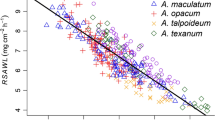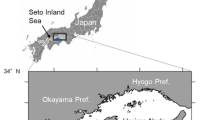Abstract
Growth of Pandalus borealis post-larval stages was measured in relation to size and temperature. Growth characteristics, including intermolt period (IP), molt increment (MI) in size and mass, and tissue allocation in juvenile, male, and female shrimp, were evaluated at 2, 5, and 8°C, the temperature range where this species is generally found in the Northwest Atlantic. Significant variations in growth were associated with temperature and shrimp size. IP (days) increased significantly with shrimp size and was inversely related to temperature. Size (cephalothorax length in mm) and temperature effects were best described by IP = 10(0.67 log(CL) − 0.06 T − 1.34). The pronounced effect of temperature on IP while MIS changed little indicated that the main influence of temperature on growth rate of P. borealis was through IP. Specific growth rate (SGRS) decreased rapidly with size to near zero values in females. Overall, juveniles were much more sensitive to temperature variations than adults, suggesting that temperatures encountered during the juvenile stage will largely influence the growth trajectory of the population.






Similar content being viewed by others
References
Aiken DE, Waddy SL (1989) Culture of the American lobster, Homarus americanus. In: Bogden AD (ed) Cold-water aquaculture in Canada. The Canadian Institute for Research on Regional Development, Moncton, pp 79–122
Anderson PJ (1999) Pandalid shrimp as indicator of ocean climate regime shift. NAFO SCR doc. 99/80 No. N4152
Anderson PJ, Piatt JF (1999) Community reorganization in the Gulf of Alaska following ocean climate regime shift. Mar Ecol Prog Ser 189:117–123. doi:10.3354/meps189117
Apollonio S, Stevenson DK, Dunton EE (1986) Effects of temperature on the biology of the northern shrimp, Pandalus borealis, in the Gulf of Maine. NOAA technical report, vol 42, 22 pp
Aschan M (2000) Spatial variability in length frequency distribution and growth of shrimp (Pandalus borealis Kroyer 1838) in the Barents Sea. J Northwest Atl Fish Sci 27:93–105
Atkinson A, Shreeve RS, Hirst AG, Rothery P, Tarling TA, Pond DW, Korb RE, Murphy EJ, Watkins JL (2006) Natural growth rates in Antarctic krill (Euphausia superba): II. Predictive models based on food, temperature, body length, sex, and maturity stage. Limnol Oceanogr 51:973–987
Benayoun G, Fowler SW (1980) Long-term observation on the moulting frequency of the shrimp Lysmata seticaudata. Mar Biol 59:219–223
Bergström BI (1992) Growth, growth modelling and age determination of Pandalus borealis. Mar Ecol Prog Ser 83:167–183
Bergström BI (2000) The biology of Pandalus. Adv Mar Biol 38:55–245
Brillon S, Lambert Y, Dodson J (2005) Egg survival, embryonic development, and larval characteristics of northern shrimp (Pandalus borealis) females subject to different temperature and feeding conditions. Mar Biol 147:895–911
Clark SH, Cadrin SX, Schick DF, Diodati PJ, Armstrong MP, McCarron D (2000) The Gulf of Maine northern shrimp (Pandalus borealis) fishery: a review of the record. J Northw Atl Fish Sci 27:193–226
Comeau M, Savoie F (2001) Growth increment and molt frequency of the American lobster (Homarus americanus) in the southwestern Gulf of St. Lawrence. J Crustac Biol 21:923–936
Ehrhardt NM (2008) Estimating growth of the Florida spiny lobster, Panulirus argus, from molt frequency and size increment data derived from tag and recapture experiments. Fish Res 93:332–337
Fu C, Quinn TJ, Shirley TC (2001) The role of sex change, growth and mortality in Pandalus population dynamics and management. ICES J Mar Sci 58:607–621
Hansen HO, Aschan M (2000) Growth, size- and age-at-maturity of shrimp, Pandalus borealis, at Svalbard related to environmental parameters. J Northw Atl Fish Sci 27:83–91
Hart RC (2001) Rapid estimation of in situ growth rates of Caridina nilotica (Crustacea: Decapoda) in Lake Victoria: description and pilot application of a simple, field-compatible technique. Limnol Oceanogr 46:692–698
Hartnoll RG (1982) Growth. In: Abele LG (ed) The biology of Crustacea. Academic Press, New York, pp 11–96
Hartnoll RG (2001) Growth in Crustacea—twenty years on. Hydrobiologia 449:111–122
Hopkins CCE, Sargent JR, Nilssen EM (1993) Total lipid content, and lipid and fatty acid composition of the deep-water prawn Pandalus borealis from Balsfjord, northern Norway: growth and feeding relationships. Mar Ecol Prog Ser 96:217–228
Iguchi N, Ikeda T (1995) Growth, metabolism and growth efficiency of a euphausiid crustacean Euphausia pacifica in the southern Japan Sea, as influenced by temperature. J Plankton Res 17:1757–1769
Kawaguchi S, Candy SG, King R, Naganobu M, Nicol S (2006) Modelling growth of Antarctic krill. I. Growth trends with sex, length, season, and region. Mar Ecol Prog Ser 306:1–15
Kinne O (1970) Environmental factors, part 2. In: Ecology M (ed) Temperature, animals, invertebrates. Wiley, London, pp 443–486
Koeller PA (2000) Relative importance of abiotic and biotic factors to the management of the northern shrimp (Pandalus borealis) fishery on the Scotian Shelf. J Northw Atl Fish Sci 27:21–33
Koeller P (2006) Inferring shrimp (Pandalus borealis) growth characteristics from life history stage structure analysis. J Shellfish Res 25:595–608
Koeller P, Fuentes-Yaco C, Platt T, Sathyendranath S, Richards A, Ouellet P, Orr D, Skuladottir U, Wieland K, Savard L, Aschan M (2009) Basin-scale coherence in phenology of shrimps and phytoplankton in the north Atlantic Ocean. Science (Wash D C) 324:791–793. doi:10.1126/science.1170987
Kulmiye AJ, Mavuti KM (2005) Growth and moulting of captive Panulirus homarus homarus in Kenya, western Indian Ocean. N Z J Mar Freshw Res 39:539–549
Lysy AY, Dvinina EA (1991) On relation of the deep sea shrimp size with oceanographic conditions in the Barents sea. ICES CM 1991/k:52
O’Brien CJ (1994) The effects of temperature and salinity on growth and survival of juvenile tiger prawns Penaeus esculentus (Haswell). J Exp Mar Biol Ecol 183:133–145
Paglianti A, Gherardi F (2004) Combined effects of temperature and diet on growth and survival of young-of-year crayfish: a comparison between indigenous and invasive species. J Crustac Biol 24:140–148
Parsons DG, Mercer VL, Veitch PJ (1989) Comparison of the growth of the northern shrimp (Pandalus borealis) from four regions of the northwest atlantic. J Northw Atl Fish Sci 9(2):123–131
Quinn GP, Keough MJ (2002) Experimental design and data analysis for biologists. Cambridge University Press, Cambridge
Ricker WE (1975) Computation and interpretation of biological statistics of fish populations. Bull Fish Res Board Can 191: 382pp
Ross RM, Quetin LB, Baker KS, Vernet M, Smith RC (2000) Growth limitation in young Euphausia superba under field conditions. Limnol Oceanogr 45:31–43
Sainte-Marie B, Bérubé I, Brillon S, Hazel F (2006) Observations on the growth of the sculptured shrimp, Sclerocrangon boreas (Decapoda: Caridea). J Crustac Biol 26:55–62
Savard L, Parsons DG, Carlsson DM (1994) Estimation of age and growth of northern shrimp (Pandalus borealis) in Davis Strait (NAFO subareas 0 + 1) using cluster and modal analyses. J Northw Atl Fish Sci 16:63–74
Shumway SE, Perkins HC, Schick DF, Stickney AP (1985) Synopsis of biological data on the pink shrimp, Pandalus borealis Kroeyer, 1838. FAO fisheries synopsis, vol 144, 57 pp
Simard Y, Savard L (1990) Variability, spatial patterns and scales of similarity in size-frequency distributions of the northern shrimp (Pandalus borealis) and its migrations in the Gulf of St Lawrence. Can J Fish Aquat Sci 47(4):794–804. doi:10.1139/f90-092
Skuladottir U, Palsson J, Bragason GS, Brynjolfsson S (1991) The variation in size and age at change of sex, maximum length and length of ovigerous period of the shrimp, Pandalus borealis, at different temperatures in the Icelandic waters. ICES CM 1991/k:5
Skuladottir U, Petursson G, Brynjolfsson SH (2005) The biology of northern shrimp (Pandalus borealis) on the Flemish Cap. J Northw Atl Fish Sci 37:147–164. doi:10.2960/J.v37.m571
Sokal RR, Rohlf FJ (1995) Biometry—The principles and practice of statistics in biological research. Freeman and Co, New York
Staples DJ, Heales DS (1991) Temperature and salinity optima for growth and survival of juvenile banana prawns Penaeus merguiensis. J Exp Mar Biol Ecol 154:251–274
Sudo H (2003) Effect of temperature on growth, sexual maturity and reproduction of Acanthomysis robusta (Crustacea: Mysidacea) reared in the laboratory. Mar Biol 143:1095–1107
Tarling TA, Shreeve RS, Hirst AG, Atkinson A, Pond DW, Murphy EJ, Watkins JL (2006) Natural growth rates in Antarctic krill (Euphausia superba): I. Improving methodology and predicting intermolt period. Limnol Oceanogr 51:959–972
Wainwright TC, Armstrong DA (1993) Growth patterns in the dungeness crab (Cancer magister Dana): synthesis of data and comparison of models. J Crustac Biol 13:36–50
Wieland K (2005) Changes in recruitment, growth, and stock size of northern shrimp (Pandalus borealis) at West Greenland: temperature and density-dependent effects at released predation pressure. ICES J Mar Sci 62:1454–1462
Winkler G, Greve W (2002) Laboratory studies of the effect of temperature on growth, moulting and reproduction in the co-occurring mysids Neomysis integer and Praunus flexuosus. Mar Ecol Prog Ser 235:177–188. doi:10.3354/meps235177
Acknowledgments
We are very grateful to L. Savard for instigating the research program on shrimp from which funding was obtained. Funds were provided by the department of Fisheries and Oceans under the Science strategic fund program on Growth and Recruitment of Northern Shrimp and by the shrimp fishermen associations of Quebec and New-Brunswick under the DFO-Group B Fishermen co-management agreement. Assistance from M. Peloquin in the design and construction of the experimental setup is gratefully acknowledged. We thank H. Dionne, S. Labrie, I. Bérudé, D, Smith, and C. Element-Boulianne for their help in conducting the experiments. We are very grateful to B. Sainte-Marie and two anonymous reviewers for helpful comments on an earlier version of the paper. Special thanks to J. Plourde for his great help with analyses using SAS. All experiments were conducted in compliance with the current laws of the Canadian Council on Animal Care.
Author information
Authors and Affiliations
Corresponding author
Additional information
Communicated by A. Atkinson.
Rights and permissions
About this article
Cite this article
Daoud, D., Lambert, Y., Audet, C. et al. Size and temperature-dependent variations in intermolt duration and size increment at molt of Northern Shrimp, Pandalus borealis . Mar Biol 157, 2655–2666 (2010). https://doi.org/10.1007/s00227-010-1526-1
Received:
Accepted:
Published:
Issue Date:
DOI: https://doi.org/10.1007/s00227-010-1526-1




